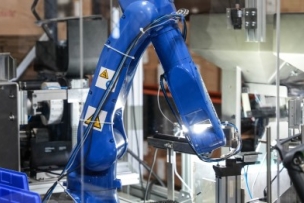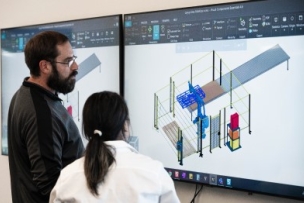The skills gap is an omnipresent theme. When you talk to manufacturers and attend conference sessions at IMTS 2018, it’s one of the most frequent topics discussed—and there is hope.
The manufacturing skills gap is a bit like the subconscious: It’s always there lurking in the background, making itself known when maybe you’d rather not be reminded of certain overwhelming things. Denial may be a river in Egypt, but it’s also a force to be reckoned with—and it needs to be addressed sooner rather than later, finds Tooling U-SME, a nonprofit organization that promotes manufacturing in the U.S.
“After the Second World War, there was a really strong development in the manufacturing economy,” says Magnus Ekback, vice president of strategy for Sandvik Coromant, during a conference session on manufacturing digitalization. “We had one or two generations that were trained and became skilled tradesmen in manufacturing. But if you were born in the 1950s, you’re going to retire.”
Think the skills gap is overblown? The data show otherwise: 99 percent of manufacturers say their top workforce challenge is finding skilled new hires, according to research released by Tooling U-SME. Its “Industry Pulse: 2018 Manufacturing Workforce Report” also found that 92 percent of companies struggle to “upskill” their incumbent workforce, and 84 percent struggle to onboard new employees.
“The lowest unemployment rate in years along with high turnover and looming retirements are adding extreme pressure to the workforce,” notes Jeannine Kunz, vice president at Tooling U-SME. “Three of the top challenges companies face in the next three years revolve around developing a skilled workforce. Yet three-quarters of the study respondents say their company does not have a talent development strategy for manufacturing employees.”
During his conference session, Ekback asked if there were any millennial attendees—and about 5 of the 25 attendees raised their hands.
“The good news is that there is plenty of opportunity,” Ekback says. “The equally good news is that the pressure is on—and there are big shoes that you have to fill. … This is something that all of us that operate in the manufacturing industry, we truly have joint responsibility to talk up the industry, to talk up manufacturing … because the challenges that we have at our workplaces, they are tremendous.”
There are issues to be reckoned with, but they are not insurmountable with the right awareness, attitude and effort, finds Tooling U-SME. From help with business leadership to culture to funding, the organization supports manufacturers that are making strategic commitments to address the skills gap head-on.
![]()
For all our coverage from the show, go to Better MRO at IMTS 2018.
How Do You Overcome the Manufacturing Skills Gap?
How do you solve this burgeoning gap?
“I don’t know—that’s a horrible challenge,” says Bob Goulding, a machine tool business manager at Seco Tools. “Gosh, if I knew that, I’d be retired already.”
It’s not easy and it will take time, but you can also take proactive measures, finds Tooling U-SME. The organization has isolated them to five best practices:
- Identifying business objectives
- Defining performance-based competency models
- Aligning learning solutions to develop knowledge and skills
- Structuring an on-the-job training program
- Developing and executing a measurable impact study
“Many workforce development actions are within employers’ control, such as retaining new hires and making positions appealing to candidates,” Kunz notes. “Solid onboarding and job qualification programs, robust blended learning and development programs, and clearly defined career pathways with skills compensation plans all contribute to a high-performance workforce.”
See how technology can help the skills gap in the video: How to Straddle the Skills Gap With Automation.
Examples of Companies Addressing the Skills Gap
During an interview with Kunz after a panel discussion at IMTS, she pointed out successful programs across a range of career development and training areas. Pella Corporation, a window and door company, implemented defined worker performance and accountability standards through a six-week onboarding training program. Honda of America Mfg. worked closely with Tooling U-SME to establish a center of excellence in manufacturing education.
“Honda worked with us in Marysville, Ohio, where they have a plant in a very rural environment, rural part of the state, and the local high school is a huge feeder of potential workers,” Kunz says of Honda’s operations in the town of Anna. “They were very much structured in how they had their competencies and their onboarding, and they wanted the school to be aligned to it.”
To help bolster the program toward success, Honda donated to SME Education Foundation’s Partnership Response in Manufacturing Education, or PRIME, to bring the training Honda uses in its Anna Engine Plant to Anna High School. Students receive training that would help them gain the foundation for employment with Honda.
Similarly, a PRIME lab was set up in Grand Haven High School in Michigan that offered students internships with Shape Corp., a tier-one automotive and industrial component supplier. The program includes four apprenticeship tracks across machine repair, tool and die, electrician and roll form. After graduation, students are fast-tracked into the company’s apprenticeship program.




Talk to Us!
Apprenticeships, Journeymanships & Master Craftsman Certification
Subject: Instilling prestige back into the U.S. craft trades via Apprenticeships, formalizing Journeymanships and creating “Master Craftsman Certifications” (As I originally expressed on “Facebook” on April 1, 2015 in response to the article entitled: “San Diego town hall: Region’s high-tech sectors need strong workforce”.)
To whom it may concern and be of interest,
One area I believe we should take a serious look at, is with our U.S. cultural perception of and the associated limited prestige afforded our apprenticeship programs and the U.S. journeyman. Unfortunately, the “journeyman” in our country has reached the pinnacle of his craft skill or profession, more than likely to spend the rest of his entire carrier at the firm in which he served his apprenticeship. We need to correct this! I would like to suggest we take a close look at those “Apprenticeships”, “Journeyman-ships” and the “Master Craftsman Certifications” as offered in Europe and Asia, that establishes far more prestige and opportunity to the vocational tradesman. This would stimulate a great deal more interest in the vocational trades as a viable and rewarding carrier opportunity.
I served a 5 yr. (10,000 hr.) apprenticeship as a Tool and Die Maker and was blessed in being able to serve in 4 different “job shops” during the course of my apprenticeship. This provided me with a wealth of diversified training and experience in my craft. I experienced a steep learning curve in the first 12 months at each of these shops, with each having different services, products, customers, equipment, approaches skills, etc., along with the Journeymen and Master Craftsmen to work under. These steep learning curves typically tend to flatten precipitously in about 14 to 18 months. This diversification of training and experience played a significant role in allowing me to be competitive and to win the 1965 Los Angeles tool & die apprenticeship contest and to go on to win in the California State competition. As a result, I have enjoyed a very successful and rewarding carrier being exposed and participating in manufacturing throughout the world.
In my opinion, based on personal experience, our apprentices should be encouraged, if not mandated, to change employers every 12 to 18 months so as to gain this diversified training and experience. Becoming a journeyman at the conclusion of your apprenticeship should NOT be the end of one’s formal training. The next 4 to 5 years as a journeyman should continue to be a formal structured educational phase in one’s professional carrier as the word “journeyman” implies and is recognized in other parts of the world. After completing his 4 to 5 yr. structured journeymanship; not spending more than 18 months of it in any one company, the journeyman would be eligible to apply for his “Master Craftsman Credentials”. This would involve the submission of a project that he had personally designed and built demonstrating his craft skills (much like a master’s or doctoral thesis) along with taking the required written and oral exams. In successfully passing your exams and having your project accepted, you will be awarded your “Master Craftsman Credentials”. In many countries, you are not allowed to have apprentices working for you unless you have the Master Craftsman Credentials in that trade and in some countries you are not allowed to even have a business in a trade without Master Credentials.
We need to expand our vocational training in these manners through to Master Craftsman status. In doing so, we would be instilling significant prestige into these craft trades and attracting many more candidates to successfully pursue vocational carriers resolving the many critical skill needs we have in our country today. The Master Craftsman, via business ownership, has the opportunity to become a multimillionaire in his or her own right and a significant contributor to our society and our economic development as a nation. This being far beyond what our current journeyman has the opportunity or expectation to achieve. It should also be pointed out that this can be accomplished without amassing a humongous “student loan debt” as is typical in pursuing other professional carriers.
I certainly recognize and appreciate that many current employers of apprentices would be very apprehensive and against such an approach. They typically are very jealous of their apprentices, expecting them to spend the rest of their carriers at their business. After all, the employers have supposedly expended all of this time, effort and expense in training them; the apprentices need to show their appreciation and loyalty by staying with the firm that taught and trained them...right? However, as this were to play out, as evidenced in other countries, the rotation of apprentices and journeymen with diversified training and experience through their business will prove to be the far greater contributors and expanders to their firm than would the long term apprentice and journeyman who are only grounded in their own undiversified, myopic and limited experience, having only been exposed to the one business’s own practices and shortcomings.
Sincerely, Tom
Thomas U. Coe
Founder & CEO
Coe Center
Res: (408) 354-2139
Cell: (209) 608-0036
email: tuc@lowtech.com
Please advise me of your thoughts and/or interest in the above concepts. Thank you.
Sincerely, Tom
29Leave a reply
Your email address will not be published. Required fields are marked *